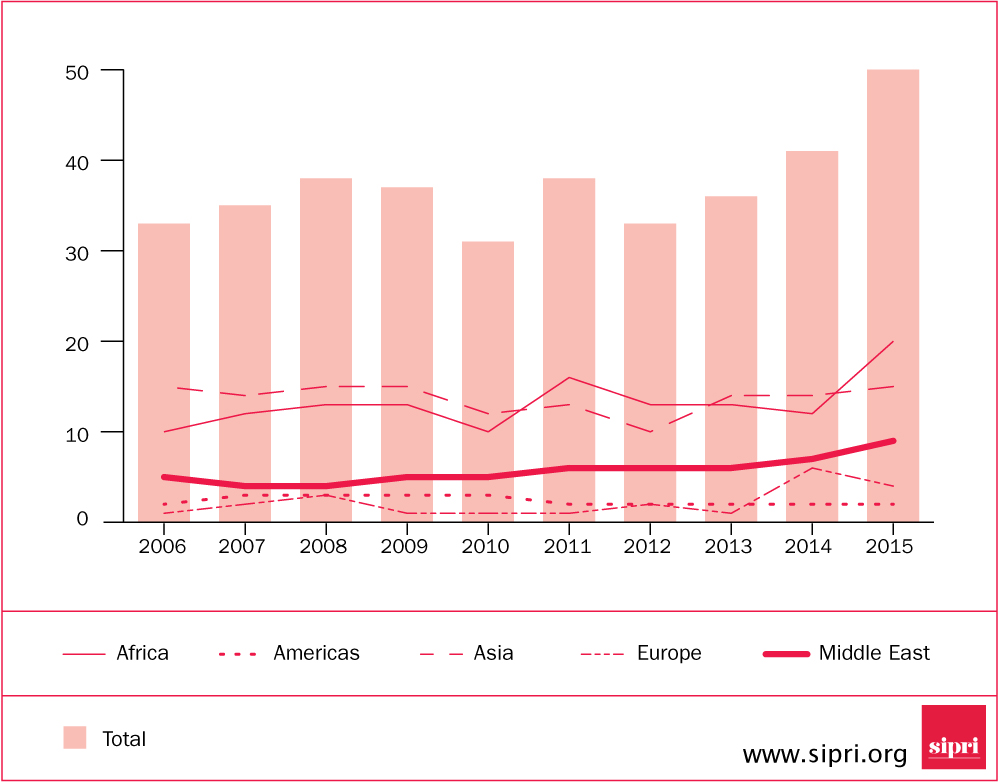6. Armed conflict data trends
Overview, Ian Davis [PDF]
I. Progress in the collection of quantitative data on collective violence, Michael Brzoska [PDF]
II. Patterns of armed conflict, Lotta Themnér and Erik Melander [PDF]
III. A reversal of peace? The role of foreign involvement in armed conflict: a case study on East Asia, Erik Melander and Isak Svensson [PDF]
IV. The state of violence and conflict in teh age of the SDGs, Clionadh Raleigh and Caitriona Dowd [PDF]
V. Casualty recording in armed conflict: methods and normative issues, Annabelle Giger, Every Casualty [PDF]
VI. The Global Peace Index, 2016, Camilla Schippa and Daniel Hyslop [PDF]
Despite the recent growth in the availability and validity of data sets on various forms of violence, major questions remain about the scope of and current trends in violence. Has there been a general, progressive decline in the level of human-inflicted violence in recent decades? If so, do current trends in armed conflict indicate a reversal of that peace?
Patterns of armed conflict, 2006–15
According to the Uppsala Conflict Data Program (UCDP), the number of active armed conflicts increased from 41 in 2014 to 50 in 2015, largely due to the expansion of the Islamic State (IS) into new territories in 12 countries. Of the 50 active conflicts, only one was fought between states (India–Pakistan). The rest were fought within states and concerned government (19), territory (29) or both (1). However, the levels of violence linked to armed conflict remain much lower than they were during the cold war, in part because the international community has developed better mechanisms for dealing with violence.

A reversal of peace? The role of foreign involvement in armed conflict
What would it take for the current upsurge in armed conflict to translate into a reversal of peace? The decline in the number of battle-related deaths since 1979 was mainly driven by the decrease in foreign involvement in the armed conflicts of East Asia. An exacerbation of the pattern of foreign involvement in armed conflict in the Middle East is the most realistic potential driver of a reversal of peace.
One particular conflict can account for a large proportion of battle-related deaths, as was the case in the 1967–75 and 1978–98 Cambodian Civil War and is currently the case in Syria. Many parallels and insights can be found in the two conflicts, most notably that a negotiated settlement to the Cambodian conflict was possible only after the foreign backers had settled their differences.
The state of violence and conflict in the age of the SDGs
Sustainable Development Goal (SDG) 16 calls on the international community to: ‘promote peaceful and inclusive societies for sustainable development, provide access to justice for all and build effective, accountable and inclusive institutions at all levels’. The transparent and systematic collection of data on political and social violence is crucial to addressing the vulnerability of citizens to violence. One of the most promising avenues is to bolster the authority and capacity of local institutions to collect, code, store, manage and analyse conflict data in a systematic way. Collecting multiple types of data will ensure that the information gathered is: (a) useful for comparative analysis and global tracking of progress towards achieving SDG 16; (b) locally defined, relevant and applicable; and (c) effective in shaping the degree to which people feel their society is just, peaceful and inclusive.
Casualty recording in armed conflict
The obligation of states to record casualties, particularly regarding the protection of civilians, remains largely unfulfilled. Accounting for military deaths has been a long‑standing practice of states, but close attention to civilian deaths is either rare or inconsistent, and there are growing calls for every casualty in situations of armed conflict to be properly recorded.
Casualty estimation can only ever aim for numbers of how many may have been killed. Casualty recording strives for definitive knowledge of who was killed, and how, when and where. The gathering of such detailed records of the dead aims to keep track of the various types of harm inflicted on a society and to humanize the victims. In many conflicts, the most effective recording is already being practised by civil society organizations. At the heart of casualty recording is the recognition and humanization of victims, and the protection of those who remain.